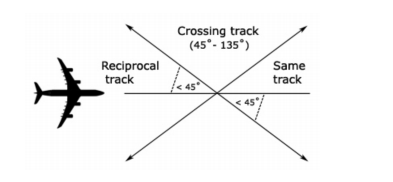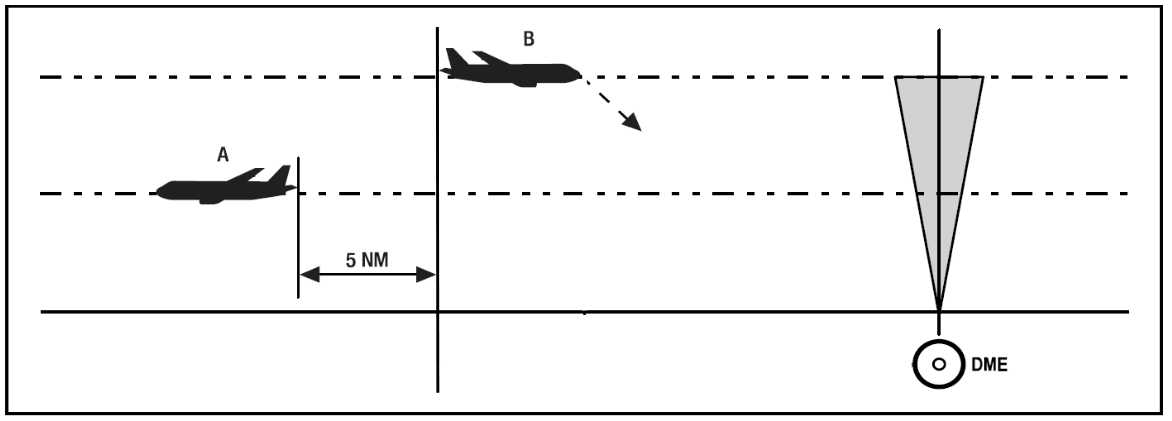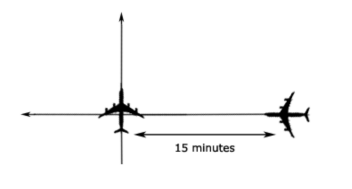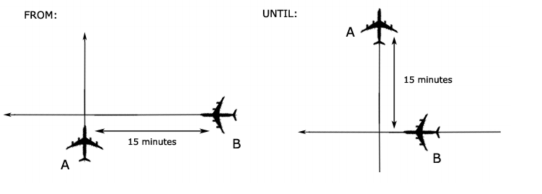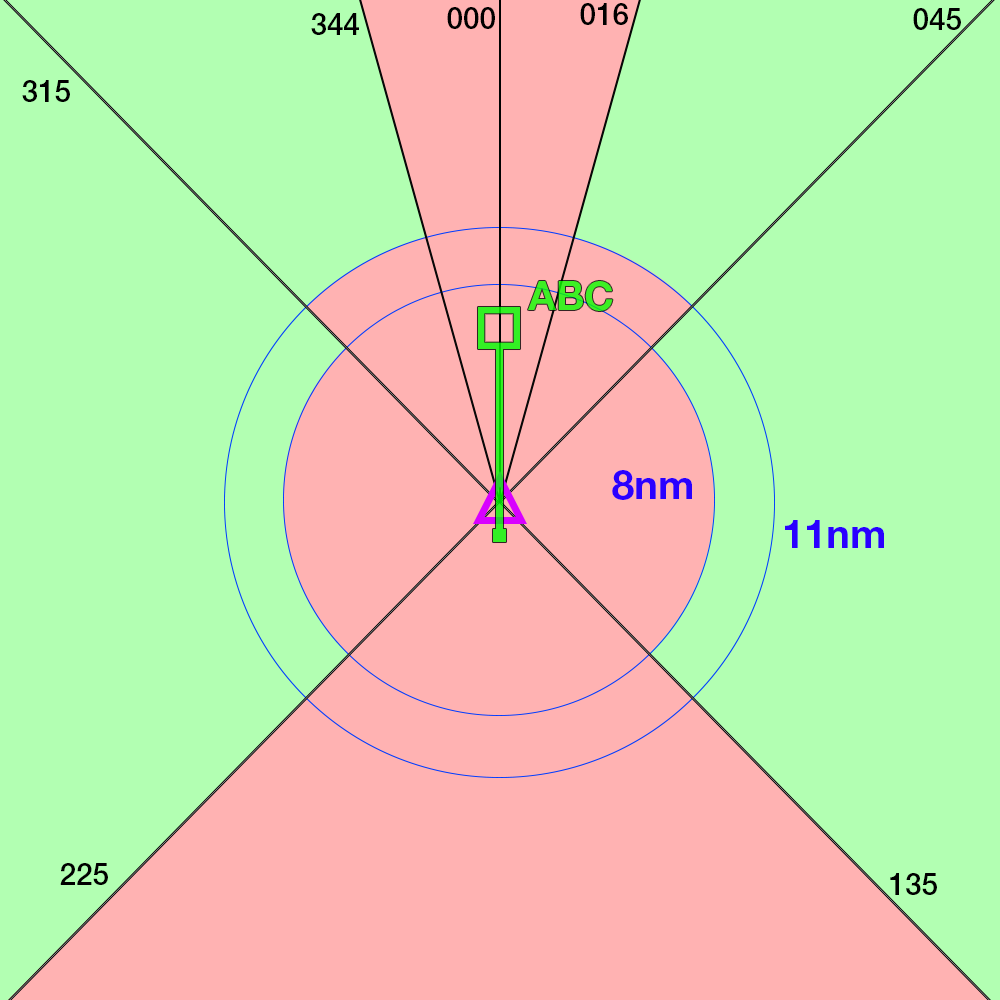Procedural Control
General
The general principles of air traffic control are the same regardless of whether procedural or surveillance methods are used (i.e. the controller monitors the traffic situations, detects and solves conflicts by providing separation, and ensures orderly flow of the air traffic). The difference lies in the way situational awareness is built and updated (by pilot reports, estimates and visual observation), the separation minima themselves (as described in ICAO Doc 4444, Chapter 5) and the support tools (flight strips instead of a situation display).
Where procedural control is employed, separation is ensured by dividing the airspace either vertically or laterally. In a Control Zone where reliable surveillance is not available, it may be classified as procedural, meaning separation is maintained using specified time or distance criteria. There are four types of procedural separation: lateral, longitudinal, vertical, and visual.
Typical Applications
Typical applications of procedural control include:
- In airspace where surveillance cover is not available (e.g. oceanic airspace or sparsely populated areas)
- In terminal movement areas (TMAs) if the traffic levels are such that they do not warrant the installation and maintenance of a surveillance system
- In aerodrome control zones (CTRs), especially if the traffic density is relatively low and the aerodrome layout is not complex (e.g. only one runway, one apron and a few taxiways)
- Backup solution in case of complete failure of all surveillance-based systems
Separation
Longitudinal Separation
Longitudinal separation is only applied between aircraft flying on identical or reciprocal tracks.
To maintain longitudinal time separation, pilot-provided estimates must be used to ensure that the time interval between two aircraft meets or exceeds the required minimum.
Time
Same Track:
Aircraft following the same track, including situations where one is climbing or descending through another’s level, must maintain a separation of at least 10 minutes.
Reciprocal Track:
Aircraft on reciprocal tracks must be separated using vertical separation. A vertical separation minimum of 10 minutes must be in place before the estimated passing time.
After the estimated time of passing, no aircraft may climb or descend through the other’s level until at least 10 minutes have passed. If positive identification of passing is confirmed, this requirement may be reduced, which will be discussed later in this section.
Distance
Distance Reports:
The lead aircraft must be navigating directly to or from the designated navigational aid. The distance report from the lead aircraft must always be obtained before requesting it from the following aircraft.
Distance checks must be performed as outlined in the table below:
| Condition | Minimum Interval for Distance Checks |
|---|---|
| No speed control applied | 15 minutes |
| Speed control applied to limit closure to ≤ 35 knots or Mach 0.06 | 15 minutes |
| Closure rate exceeds 35 knots or Mach 0.06 | Standard is not valid |
| Speed control applied to maintain a stable or increasing separation | 30 minutes |
Methods of Ensuring Distance-based Separation:
| Method | Conditions | |
|---|---|---|
| 20nm Exists Between |
|
|
| 5nm Definite Passing |
|
|
| Sight and Pass |
|
|
| Opposite Side of Visual Fix |
|
Lateral Separation
Time-based Crossing Track
Aircraft on crossing tracks, including cases where one is climbing or descending through another’s level, must maintain a separation of 15 minutes at the intersection point.
If a 15-minute separation cannot be ensured at the crossing point, vertical separation must be applied. This vertical separation remains in effect from the time the second aircraft is 15 minutes from the intersection until the first aircraft has passed it by 15 minutes.
Lat Sep Table
Lateral separation is determined based on the concept of a Lateral Separation Point (Lat Sep point)—the distance at which procedural lateral separation is considered to exist, depending on the angle of intersection between two tracks. The required separation distances are outlined in the table below:
| Intersection Angle | Required Separation |
|---|---|
| 0° - 15° | No lateral separation |
| 16° - 44° | 11nm |
| 45° - 135° | 8nm |
| 136° - 180° | No lateral separation |
Visually, an aircraft at point ABC is considered laterally separated from aircraft in the green zones, whereas it is not laterally separated from aircraft in the red zones. These criteria only apply when both aircraft are tracking directly to or from the crossing point.
This method is particularly useful for planning restrictions when surveillance coverage is not guaranteed.
Vertical Separation
Vertical separation is the most commonly used method in non-radar environments, allowing controllers to maintain aircraft at different flight levels without the risk of loss of separation—unless one aircraft needs to climb or descend.
The primary reference for aircraft altitudes and assigned levels is pilot-reported data.
| Altitude / Flight Level | Separation Standard |
|---|---|
| SFC - FL290 | 1000ft |
| FL290 - FL410 | RVSM: 1000ft, Non-RVSM: 2000ft |
| FL410 - FL600 | 2000ft |
| Any Supersonic Aircraft, regardless of FL | 3000ft |
RVSM airspace is only applicable between FL290 and FL410.
An aircraft cannot be cleared to climb or descend into a level that was previously occupied by another aircraft until that aircraft has confirmed it is clear of the relevant levels.
Procedures
Timed Approaches
Timed approaches, utilizing either nonradar procedures or radar vectors to align aircraft with the final approach course, may be conducted at airports with an active tower or approach controller, provided the following conditions are met:
-
The procedure relies on appropriate NAVAIDs and either standard or special instrument approach procedures, or sufficient radar coverage to facilitate:
- Aircraft holding at a designated fix on the approach course or receiving radar vectors for a straight-in approach while adhering to specified minima, including wake turbulence requirements.
- Aircraft proceeding toward the airport along the approach course while crossing the holding or approach fix at an assigned altitude, if required.
- Aircraft continuing descent to execute an approach at the destination airport.
-
Continuous communication must be maintained with the aircraft until the pilot is instructed to switch to the tower frequency.
-
If multiple missed approach procedures exist, none should require a course reversal.
-
If only one missed approach procedure is available, the following conditions must be met:
- A course reversal is not necessary.
- The reported ceiling and visibility meet or exceed the highest prescribed circling minimums for the approach in use.
Ceiling minima are determined by comparing the Minimum Descent Altitude (MSL) with the reported ceiling (AGL) plus the airport elevation.
Approach Sequence
Once an aircraft passes the final approach fix inbound (for a nonprecision approach) or the outer marker or equivalent fix inbound (for a precision approach), clearances for subsequent timed approaches should be issued as follows:
- Clear the following aircraft for approach, instructing it to descend to the altitude vacated by the preceding aircraft.
- Assign a specified time for the following aircraft to cross the final approach fix or outer marker inbound.
- When using radar to manage sequencing, vector aircraft to cross the final approach fix or outer marker at the assigned time.
If an alternative missed approach procedure is unavailable and weather conditions are below the required minima, the next aircraft should only be cleared for approach once the preceding aircraft has landed or canceled its IFR flight plan.
All aircraft must be transferred to the tower frequency before reaching the final approach fix.
Sequence Interruption
If necessary, the established approach sequence may be interrupted to accommodate aircraft executing a different type of approach.
Level Flight Restriction
When weather conditions indicate that an aircraft will be in IFR conditions at the final approach fix (for nonprecision approaches) or the outer marker or equivalent fix (for precision approaches), the second aircraft must be cleared for approach early enough to ensure at least one minute of level flight before crossing the final approach fix or outer marker.
Additional spacing should be applied when needed, considering:
- The relative speeds of the aircraft involved.
- Current weather conditions.
- The distance between the approach fix and the airport.
- The type of approach being conducted.
Time Check
Prior to issuing a specific time for an aircraft to depart the approach fix inbound, a time check should be provided—unless the aircraft is being vectored to the final approach course.
Missed Approaches
- If weather conditions suggest a missed approach is likely, an alternative missed approach procedure should be assigned to the next aircraft.
- If an aircraft executes a missed approach, the next aircraft may continue the approach only if it has been assigned an alternative missed approach procedure.
- Radar control must be maintained, or remaining aircraft must be held at their assigned altitudes until conditions permit issuing further approach clearances.
In cases where a timed approach sequence is in place and an aircraft misses an approach:
- Retain radar control of subsequent aircraft or instruct them to maintain their last assigned altitude (at or above the minimum holding altitude).
- The aircraft should return to the holding or approach fix and remain there until approach clearance can be issued under safe traffic conditions.

